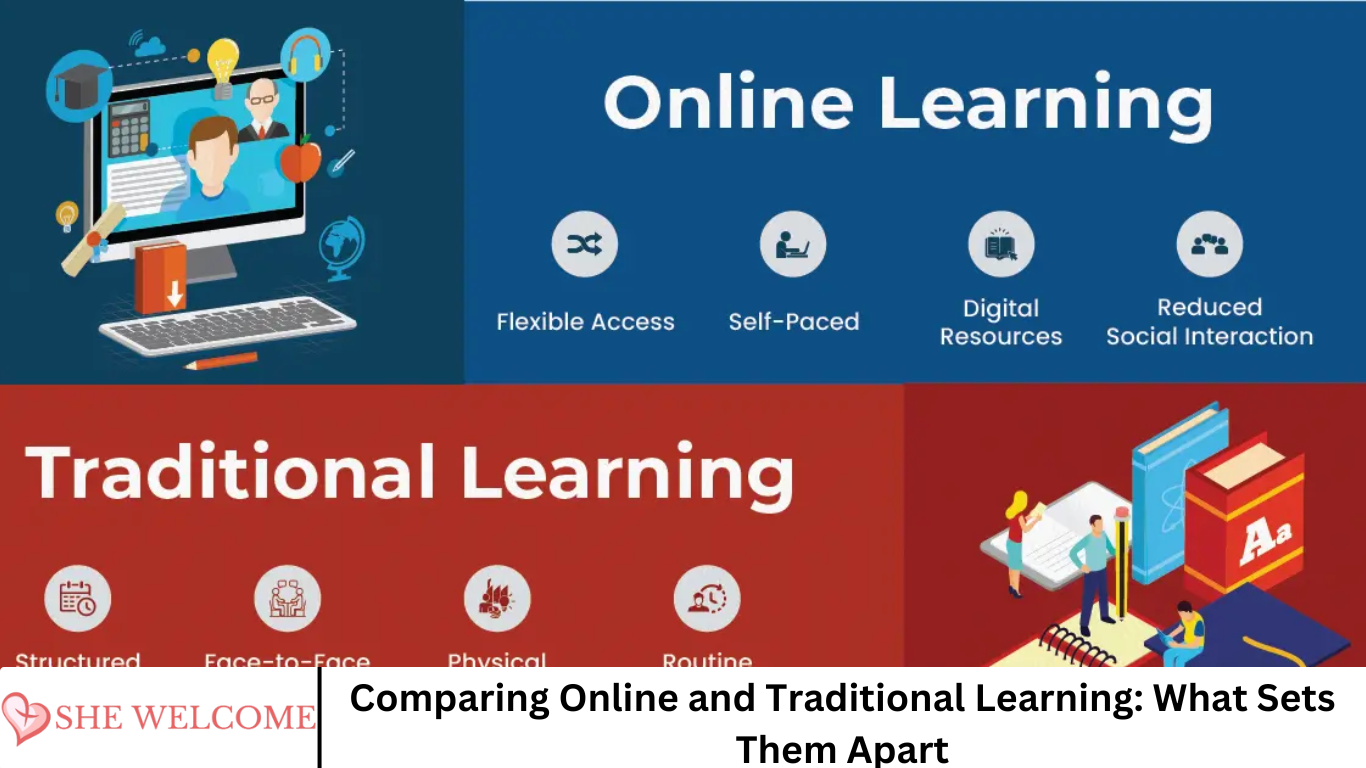In an era defined by rapid technological progress and evolving education needs, the debate between online learning and traditional classroom education has intensified. With the global online education market projected to reach US $279.30 billion by 2029, growing at a CAGR of 8.56% from 2024 to 2029, it’s clear many learners and educators are embracing the digital shift.
Whether driven by convenience, flexibility, cost, customization, or accessibility, online learning offers compelling benefits that challenge the longstanding dominance of traditional, face-to-face classroom settings. Yet, brick-and-mortar education remains deeply rooted in pedagogical traditions that emphasize in-person interaction, structured environments, and direct peer engagement.
As modern learners navigate a world of hybrid possibilities, understanding the distinctive advantages and limitations of both online and traditional education is critical for choosing the approach that best aligns with personal, professional, or organizational goals.
More Read: Lifelong Learning: A Key to Ongoing Professional Growth
1. Defining the Modalities
What Is Online Learning?
Online learning—often called e-learning or virtual learning—refers to content delivered electronically via the internet. Courses may include:
- Synchronous classes: live video lectures, discussions, and real-time interactions.
- Asynchronous classes: recorded lectures, self-paced modules, and digital assessments.
Virtual platforms include LMS (Learning Management Systems) such as Canvas or Moodle, video conferencing tools, discussion forums, and mobile learning apps.
What Is Traditional Learning?
Traditional learning occurs in physical classrooms with in-person instruction. It features:
- Structured schedules: fixed class times and locations.
- Direct interaction: immediate dialogue between teachers and students.
- Physical presence: hands-on activities, labs, and live presentations.
Think schools, universities, vocational training centers, or corporate training classrooms.
2. Accessibility and Flexibility
Convenience and Reach
Online learning breaks geographical barriers. A student in Lahore can take a course taught by a professor in London without leaving home. With just a device and internet connection, learners gain access to diverse, global curricula. This flexibility is especially attractive to:
- Working professionals balancing career, family, and education.
- Learners in remote or underserved regions.
- Busy parents and caregivers.
Synchronous delivery provides structured learning through live sessions, while asynchronous formats offer complete control over pacing and schedule.
Limitations of Traditional Timing
Traditional education demands physical presence in fixed schedules and locations. While this structure offers routine and accountability, it can clash with learners’ personal or professional responsibilities. Commuting, formal attire, and strict attendance policies can become burdens, especially for those juggling multiple roles.
3. Interaction and Engagement
Engagement in Online Learning
- Live video sessions (Zoom, Teams) simulate classrooms but may suffer from lag or multitasking distractions.
- Discussion forums and chats promote reflection and peer learning.
- Interactive quizzes and polls (e.g., Kahoot!, Mentimeter) maintain attention and reinforce content.
Online platforms that leverage gamification, peer feedback, and breakout rooms often boost student engagement. However, some students may feel isolated or struggle without face-to-face accountability.
Engagement in Traditional Classrooms
The immediacy of tone, facial expressions, and group dynamics is a significant strength of in-person classrooms. Teachers intuitively read the room and adjust teaching styles accordingly. Collaboration comes naturally—group projects, simulations, debates, and labs thrive in physical settings.
Yet, vocal or socially confident students may dominate, while quieter learners remain marginalized unless the instructor proactively fosters inclusivity.
4. Pedagogical Approaches & Instructional Design
Online Education Design
Crafting effective online courses demands thoughtful instructional design. Leading platforms rely on Bloom’s Taxonomy, multimedia assets, and rich interactions. Typical structure:
- Microlearning segments for focused learning.
- Scaffolded modules that build on previous knowledge.
- Built-in assessments: quizzes, peer reviews, flashcards.
- Immediate feedback through automated grading.
Adaptive learning tech can personalize content based on learner performance and needs.
Traditional Instruction Methods
Traditional classrooms often favor lecture-based delivery supplemented by homework, group work, and manual grading. While dynamic, teacher-led discussions foster critical thinking, instructional design tends to be linear and instructor-paced, lacking customization.
Hands-on methods—labs, role play, field trips—offer experiential learning that’s hard to replicate online (though increasingly possible with VR/AR tools).
5. Technology Infrastructure Requirements
Online Learning Infrastructure
A sturdy experience requires:
- Reliable high-speed internet and learning platforms.
- Access to devices: computers, tablets, or smartphones.
- Tools like headphones, webcams, and installed software.
- Institutional support: setup guides, troubleshooting, and digital literacy training.
- Upkeep: regular updates to platforms, content, and security.
Traditional Classroom Infrastructure
Traditional settings rely on:
- Physical classrooms, electricity, heating/cooling.
- Sinks, lab instruments, projectors, and whiteboards.
- Campus amenities: libraries, study rooms, physical resources.
- Overheads: cleaning, maintenance, security, and utilities.
While less digitally intensive, these setups require significant physical and logistical investment.
6. Cost Comparison
Costs of Online Learning
Pros:
- Opens access to low-cost courses, MOOCs, and microcredentials.
- Savings on commuting, housing, and physical material.
- Scales well digitally—platform development spreads fixed costs across many learners.
Cons:
- Upfront tech investment, software licenses, and IT staff support.
- Increased cybersecurity and maintenance expenses.
Costs of Traditional Learning
Pros:
- No extra home technology needed.
- Lowest tech bar—physical materials used in-class.
Cons:
- Operational costs: facilities, utilities, maintenance, travel expenses, staff salaries.
Ultimately, online learning often delivers better cost-effectiveness per learner—especially at scale. Traditional models may be expensive on a per-student basis due to recurring institutional costs.
7. Learning Outcomes & Effectiveness
Research on Online Learning Effectiveness
Studies show:
- Online learners sometimes outperform their classroom counterparts in knowledge retention and application skills, especially when interactive tools are used.
- Self-paced learning fosters deeper reflection and thoughtful responses.
- Success often depends on learner motivation and proficiency with technology.
Strengths of Traditional Classroom Outcomes
- Perfect for hands-on training, social skills, and performance-based assessments.
- Environments like labs or workshops offer direct, supervised experimentation.
- In-person peer collaboration can enhance teamwork, emotional intelligence, and real-time problem-solving.
Matching Modalities to Context
- A blended/hybrid model often yields superior results—leveraging digital lectures with in-person labs.
- Where interpersonal skills or physical mastery are paramount (like healthcare, dance, engineering), traditional methods remain essential.
- For scalable theoretical knowledge, certification, or professional upskilling, well-structured online courses deliver results.
8. Personalization & Pacing
Online Adaptive Learning
Digital platforms enable:
- Adaptive learning paths, tailored quizzes, and progress-driven content.
- Microlearning modules allowing learners to focus on weak areas.
- Automated tracking and analytics give both learners and instructors insight into strengths and weaknesses.
Traditional One-Size-Fits-All
In structured classrooms:
- Pace and content are standardized.
- Remedial instruction depends on teacher bandwidth.
- While teachers can differentiate (e.g., mixed-ability groups), it’s harder to personalize at scale.
9. Social Interaction & Networking
Online Networking
While virtual, online education supports:
- Discussion forums, peer-reviewed assignments, and group chats.
- Global networking—learners from multiple countries bring diverse perspectives.
- Virtual events, webinars, and alumni platforms.
However, relationships may feel less deep due to lack of face-to-face contact, serendipitous meetings, and informal interactions.
Classroom Networking
Physical environments allow:
- Spontaneous conversations before, after, or between classes.
- Mentorship, peer collaboration, group projects, communal activities.
- Permanent networks formed during in-person programs, especially within universities.
These organic social experiences are often cited as the highlight of traditional education.
10. Flexibility & Scalability
Online learning scales impressively: a single course can be served to hundreds or thousands globally with minimal extra cost. Automatic grading and digital content delivery help handle large audiences.
Traditional formats face space and instructor limits, with finite class sizes and schedules. Scaling requires more resources.
However, online models demand robust infrastructure and learner self-discipline to function effectively.
11. Credibility & Recognition
Online Certifications
Prestigious universities increasingly offer legitimate, accredited online degrees. Many employers now value MOOCs and microcredentials, though in some regions, skepticism of online-only credentials still persists.
Traditional Diplomas
Traditional degrees often carry weight due to established institutions, brand recognition, supervisor validation, and alumni prestige. In some professional fields, they remain the default credential.
The ideal route is to evaluate accreditation, provider reputation, and employer perception when choosing online or traditional credentials.
12. Challenges & Limitations
Online Learning Challenges
- Learner isolation and lack of motivation.
- Technology access gaps—connectivity and digital devices are prerequisites.
- Cheating concerns without secure proctoring.
- This reduces suitability for young children or highly interactive apprenticeships.
Traditional Learning Challenges
- Inflexibility with scheduling and location.
- Limited access for non-traditional learners.
- Potential for higher per-student costs.
- Lack of digital agility: slow adaptation to emerging tech and remote learning demands.
13. Blended Learning: The Best of Both Worlds
Blended or hybrid education combines the flexibility of online learning with the hands-on benefits of traditional methods. For example:
- Flipped classrooms: learners watch online lectures and use in-person time for collaboration.
- Virtual labs augment physical experiments with simulations.
When well-implemented, hybrid models yield better engagement, outcomes, and economic efficiency—though they require more sophisticated planning and coordination.
14. Key Takeaways & Decision Guide
| Criteria | Online Learning | Traditional Learning |
|---|---|---|
| Flexibility | High; self-paced, global access | Low; fixed schedule, physical presence |
| Interaction | Digital (forums, chats) | In-person, spontaneous, immediate |
| Instruction Quality | Multimedia, adaptive | Direct, nuanced, hands-on |
| Cost Efficiency | Generally lower per learner | Higher, location-dependent |
| Outcome Suitability | Theoretical, scalable, self-paced learning | Experiential, social development, labs |
| Networking | Virtual, global connection | Face-to-face bonding and mentorship |
| Infrastructure Needs | Digital devices + internet | Classrooms, equipment, utilities |
| Credential Credibility | Growing recognition, variable by provider | Well-established institutional value |
| Ideal For | Working professionals, remote learners, theory-heavy fields | Hands-on vocations, youth & social learning |
| Limitations | Digital divides, engagement obstacles | Inflexibility, high overhead |
Choose based on learning objectives, lifestyle, budget, and desired credential.
Frequently Asked Question
What are the main differences between online and traditional learning?
Online learning is conducted through digital platforms, offering flexibility, self-paced study, and remote access. Traditional learning occurs in physical classrooms, featuring face-to-face interaction, structured schedules, and hands-on activities.
Is online learning as effective as traditional classroom education?
Yes, when well-designed, online learning can be just as effective—sometimes more—than traditional learning. It supports personalized pacing and interactive tools, but success depends on the learner’s motivation, access to technology, and course quality.
Which is better for working professionals: online or traditional learning?
Online learning is generally better for working professionals due to its flexibility, self-paced structure, and 24/7 accessibility. It allows learners to balance their studies with work and personal commitments more easily than traditional classes.
What are the disadvantages of online learning compared to traditional learning?
Online learning may lead to feelings of isolation, lower engagement, and challenges with motivation or discipline. It also requires reliable internet and digital devices. Traditional learning, on the other hand, provides direct interaction, immediate feedback, and a structured environment.
Is online education recognized by employers like traditional degrees?
Many employers now recognize accredited online degrees and certificates, especially from reputable institutions. However, recognition may vary by industry and region, so it’s important to choose accredited programs with strong reputations.
Can online learning fully replace traditional classroom education?
While online learning is effective for many subjects, it may not fully replace traditional education in fields requiring hands-on training (e.g., medicine, engineering). A blended learning approach often combines the strengths of both.
How do costs compare between online and traditional education?
Online learning is often more cost-effective due to lower tuition, no commuting costs, and reduced material expenses. Traditional education tends to have higher fees due to facility use, staff, and infrastructure maintenance.
Conclusion
Online and traditional learning each offer unique strengths, and the best choice depends on your personal goals, learning style, and circumstances. Online learning excels in flexibility, accessibility, and cost-efficiency—ideal for self-motivated learners and working professionals. Traditional education, on the other hand, provides structure, face-to-face interaction, and hands-on experience that can be essential for certain fields. Rather than viewing them as rivals, consider how they can complement each other. Blended learning models are increasingly popular, combining the convenience of digital education with the depth of in-person engagement.


